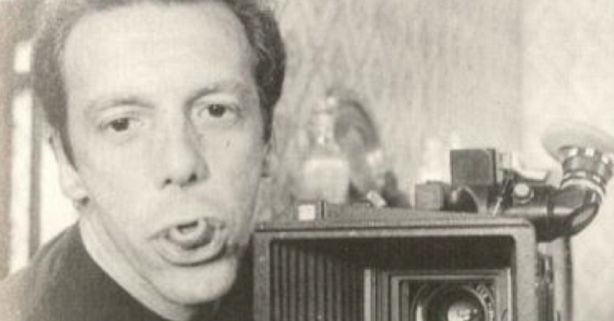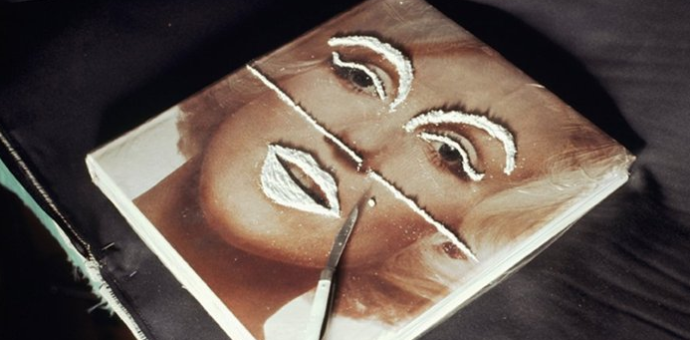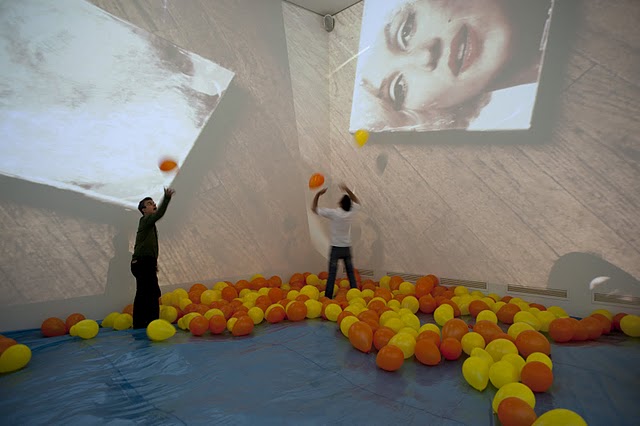Trash-Imagist Outlaw: The Cosmococas of Hélio Oiticica
22.06.15

Jean-Louis Baudry utilized a Lacanian approach to cinema in “Ideological Effects of the Basic Apparatus,” suggesting that self-identification or self-verification with the cinematic “mirror-screen” of any room containing a projected image (like that of the self-verification of one’s body reflected back at them in a mirror) is a moment when a human being is forced to physically look at and confront a representation. Like an outlaw staring down a potential attacker during a quick draw at sunrise, the spectator “identifies less with what is represented, the spectacle itself, than with what stages the spectacle, makes it seen, obliging him to see what it sees; this is exactly the function taken over by the camera as a sort of relay.” It is precisely this example of mandatory seeing—this representation’s authoritative exertion of power over a spectator—that aggravated artist, Hélio Oiticica. In fact, his aggravation grew to the point where he desperately sought nothing more than to rid himself of the representative nature of the image itself.
But how can one escape this problematic mandatory seeing? How can any artist escape the representative nature of an image without simultaneously utilizing images or representations? How can any artist oppose the representative nature of mediums like film or photography without simultaneously utilizing film or photography?
Oiticica was very much influenced by other artist-as-outlaw types including Andy Warhol, Jean-Luc Godard, Arthur Rimbaud, Kenneth Anger, and Jack Smith. In fact, he once affectionately cited Jack Smith as the “Artaud of cinema.” With an emphasis on cocaine as pharmakon and an interest in further romanticizing the outlaw as a kind of hero, Oiticica took to his journal in March of 1973 to develop a highly-extravagant nine-part installation of immersive environments that could somehow exist somewhere “beyond representation,” as he put it. A somewhere called Cosmococas. However, after suffering a sudden stroke in 1980, the artist did not live to see the completion of his ninth environment, “Coco Oculta,” and his seventh untitled Cosmococa environment simply never came to fruition, but his seven additional environments were exhibited in New York City in 1973. Oiticica’s seven simulacra were initially the result of his coming to terms with the self-preserving spectacle of New York City. Again, this idea of spectacle as something that makes itself “seen,” to echo Baudry, was excruciatingly dissatisfying to Oiticica. Not only was 1970s New York City making itself seen, but the city itself also consistently signified a proliferation of new and experimental art scenes. To fulfill his goal—to eventually position himself outside of it all—Oiticica simultaneously had to exist inside these art scene circles, but only for a temporary period of time. He successfully socialized with a variety of Warhol’s superstars, but, ultimately, he was repelled by Warhol’s obsession with fame. He was possibly also repelled by the very idea of a ‘superstar.’
Oiticica’s exhibition was less of a traditional, recognizably gallery-esque exhibition and more of what he referred to as a “quasi-cinema” experience. Oiticica loosely defined the quasi-cinema experience as a sort of Baroque mosaic of non-verbal, non-narrative, and non-diagetic imagism projected on walls. A trash-imagism! Intentional and acknowledged wastefulness. Unapologetic celebration of room after room of horror vacui. A bombardment of waste, trash, and an engulfing uselessness frequently associated with nudity and eroticism within the simulacra of the Cosmococas. Perhaps Severo Sarduy says it best in his essay, “Baroque and the Neobaroque,” by reminding us:
Baroque language delights in surplus, in excess, and in the partial loss of its object. Or better yet, in the search, frustrated by definition for the partial object.
The Cosmococas attendees—or, better yet—audience members, did not necessarily sit down to view these projected images. Actually, most of them probably passed out on a cushion, in a hammock, or buried themselves under piles of balloons. Like corpses. Audience members were invited to very leisurely tour environment after environment after refusing or denying opportunities to huff nitrobenzol or non-toxic jasmine from handkerchiefs via small penicillin bottles, trade clothing with complete strangers, or even drink from a can of Coca-Cola. In Oiticica’s personal notes he describes the drug abuse as a sort of “family” scene where people are eating “normally around a table.” He later notes that there is a man sleeping in one of the Cosmococas wearing a woman’s night dress. He called these materials “sensorial elements.” Each environment was filled with sensorial elements as well as various projected images corresponding to recordings of pop music or rapid percussion compositions. The environments included, “CC1: Trashiscapes,” “CC2: Onobject,” “CC3: Maileryn,” “CC4: Nocagions,” “CC5: Hendrix-War,” “CC6: Coke’s Head Soup,” and “CC8: Mr. 8 or D of Dado.” To recreate how one’s sensorial experience might play out, here’s a poem-like excerpt from Oiticica’s journal:
IDEA 8—NO TAKE—complete darkness for 10 mins.
Pop record playing strong music
IDEA 9—take 1—1 SCREEN for first 10 mins.
3 SCREENS (after 2nd person enters scene) for the remaining 20 min. Total 30 mins.
—Audience touches & plays with sensorial elements by Ligia Clark, passing around from one end.
IDEA 10—NO TAKE—Ligia Pape’s “PLEASURE CIRCLE”
Ice cream cups with different liquids that bear different tastes
to taste liquids
FLOOD LIGHTS throwing purple light making central big lighted circle area
Tape (made in Rio) playing drum rhythms
The various environments that make up the Cosmococas seem rave-like. Possibly even fun. Perhaps the Cosmococas are fit for only outlaws. In his journal, Oiticica wrote, “[…] a Cosmococa incorporates discontinuously and at the same time is fed by what I’d call the experimental camp in what I define as Brazilian experimentation: the existence of such a camp is real and strong: like time it will show itself to be stronger than what is in Paris (unsurpassed): Brazil is more important than Paris but less limited culturally and less provincial: as Mario Pedrosa says, Brazil is a country condemned to the modern: ignorance ends up minimizing the cultural (even if it’s true that it brings the negative with it.” Oiticica’s unapologetic Brazilian baroqueness was an opportunity to scrawl across or color in the empty spaces of an American culture of superstardom that was otherwise ignorant to a history of baroque art.

Walter Benn Michaels once asked, “How can paint become a picture?” When I began researching Oiticica, my initial question was: How can cocaine become a paint? Taking Oiticica’s concept of the heroic outlaw into consideration, I think it is important to note Michaels’s assertion that “only the unnatural makes representation possible, and it makes it possible by imagining the natural as artificial,” and this is primarily because the cocaine paintings, whether projected as quasi-cinema or actually viewed on a tangible slab of aluminum, are always already natural and unnatural. Michaels’s ‘natural as artificial’ point of view combined with the recommended drug-induced state of Oiticica’s Cosmococas creates a rare opportunity for audience members when considering the possibilities of ‘other minds’ and their ‘own minds.’ Maybe this is a reason for the encouragement of swapping clothes with another audience member (which could also provoke a person’s first-time experience with drag).
An example of one of these environments would be “CC5: Hendrix-War;” a room filled with the bodies of contemplative audience members reclining in outstretched hammocks. Projected on the walls and ceiling of the room were photographs of a cover of Jimi Hendrix’s War Heroes album. However, both the shape and details of Hendrix’s face on the cover were altered either by patterned lines of cocaine (possibly mimicking the branching out of one’s CNS) or Coca-Cola-labeled books of matches obstructing one’s view of his mouth. Other projected images of the same album cover included a rectangular line of cocaine surrounding Hendrix’s mouth and, finally, an image in which the celebrity icon has been completely disappeared by both a desert of cocaine and the glare of a photographer’s flash bulb. I think it’s important to consider the likeliness of audience members being in a neurologically altered frame of mind (i.e. the nitrobenzol huffing and god knows what other drugs were brought inside by guests). Accessibility to his trash-imagist environments does not appear to be Oiticica’s goal. Neural violence does. A neural violence that causes an audience member to transgress to Oiticica’s own outlaw-as-artist status. In regard to War Heroes and war itself, Oiticica has said, “Violence is justified as a means of rebellion, but never as a means of oppression.”
Oiticica appears to have been attracted to the illegality of cocaine’s outlawed status, its harmful, excrement-like socioeconomic consequences, and its coca plant medicinal history associated with the Incas. Cocaine appears to be a kind of jouissance for Oiticica. A pharmakon of joy and terror. Pleasure and pain. As an artist’s tool, a material used to produce either obstruction or impasse. Cocaine is suddenly recognized as the same substance it has always been and, at the same time, a different kind of substance altogether. It’s interesting to consider the possible auditory hallucination side effect and its relationship to one of Oiticica’s environments in which non-diagetic sound was, from the point of view of a sober audience member, originally intended to clash with projected trash-images. If one were to reach a nearly unconscious state via nitrobenzol poisoning, an audience member in one of these environments might eventually resemble something as unproductive as the environment itself. An audience member crippled by quasi-cinema might have more or less resembled the artist-as-outlaw Oiticica himself: equally repulsed and dismayed by the representative nature of an image. Carlos Basualdo chose to define Oiticica’s trash-image as a “pure residue that does violence to the very process of value production as value for accumulation.”
Whether it’s a cocaine-saturated portrait of Marilyn Monroe (“CC3: Maileryn”) or a similarly cocaine-saturated image of Jimi Hendrix, there’s something arguably very real (i.e. one participates, one is presumably ‘under the influence’ during the act of looking) and very false (i.e. the projected images of the cocaine-saturated artworks) regarding the cocaine as a disrupting force in terms of the original auratic quality of the photographed celebrity icon. The provocative implication is that audience members must disappear the pharmakon and subject. I also understand the dilemma of one’s physiology, especially in regard to an Albertian map of seeing. I guess this is why I am interested in Oiticica’s fully (dis)embodied viewer as something maybe not triumphant, but capable of phantasmically existing outside of binarian perceptions of logic aka outlaw vs. law-abiding citizen; seeing vs. blinded; or consumer vs. transgressor. Warhol functions as a self-appointed spectacle demonstrative of a fame that spectators aspire to while Oiticica is more interested in obliterating spectators with obliterated/obliterating representations. Thus the spectator is left blown wide open, wounded by the conflicting zone of the middle ground. This Baroque quasi-cinema containing no wasted space (i.e. balloon pile-ups, drugs, cushions, hammocks, walls covered in projected trash-images, a lack of an identifiable surface) is a way for the spectator to assume the seemingly unattainable Warholian throne.
What if the ideal ground of vision, as far as Oiticica is concerned, is always already in a state of decay? What happens if one thinks of the Cosmococas as simulated ruins? A Cosmococas audience participates within the environments by interacting with the ruined celebrity iconography as if there is nothing unappealing about the public defacement of such iconography. The floor of “CC3 Maileryn” contained hundreds of sensorial balloons, which attendees could pick up and toss around as if attending a party. The floor of “CC4 Nocagions” offered a swimming pool that attendees could dive into. Meanwhile, projected images of a cocaine-smeared copy of John Cage’s Notations fill “CC4” along with pulsing percussion music. It appears that once spectators are fully emerged in Oiticica’s quasi-cinema apparatus, icons become ruins and spectators become their own different kind of superstar. Does this make the Cosmococas spectators free? Or are the spectators still just zombie-like “victims of torture,” as Slajov Žižek might put it, swaying mindlessly amidst remnants of celebrity? In his essay, “Welcome to the Desert of the Real,” Žižek discusses the way pornographic snuff films brutally fulfill seemingly “infinitized” bodies (i.e. celebrity icons) with the American fantasy of death. Just as one might obsessively seek out ruin photography of derelict neighborhoods in bookstores, there is something arguably pornographic about the way spectators give in to dancing and lounging about within the Cosmococas. The temporary obliteration of the cocaine-erased superstar grants any desirous spectator access to a newly available fantasy role.

Oiticica isn’t showing spectators what Marilyn Monroe is. Oiticica is presenting spectators with an erasure of Marilyn Monroe and those same spectators, complicated by the side-effects of drugs, repetitive music, and opportunities to perform in drag, are left asking, “What is that? Who is that? Where am I?” Like pornography, one’s desired object can quickly lead to a never-before-realized disgust, but if one’s environment is an environment of rampant degradation and wholly grotesque, one is left with no choice but to become a spectacle of that degradation. A new outlaw with outlaw-status that differs from Oiticica’s own outlaw-status. The celebrity ruin porn of Hélio Oiticica’s Cosmococas remains incendiary because it simultaneously acknowledges a society’s visual fascination with celebrity iconography while posturing spectators to confront the very same social idealization of the celebrity as a commodity. In his journal, Oiticica admitted that he wanted to:
open up a chance-way in which I can participate as INVENTOR without being restricted by my status as a necessary element
The word “inventor” is quite an odd term in this instance. Typically, innovation is associated with the future. Inventors are typically future-minded. But Oiticica appeared to be most interested in contributing to the present tense of art and far less interested in the future. Any art world professional immersed within a Cosmococa needn’t worry about investing in any superstars. There are no monumental superstars in the Cosmococas. There is no New York art scene. There is no future to invest in. There is only the outlaw.